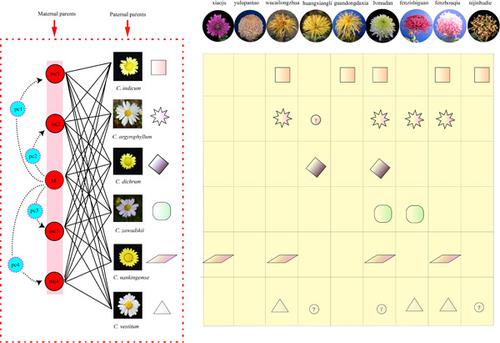当前位置:
X-MOL 学术
›
J. Syst. Evol.
›
论文详情
Our official English website, www.x-mol.net, welcomes your
feedback! (Note: you will need to create a separate account there.)
Origins of cultivars of Chrysanthemum ‐ evidence from the chloroplast genome and nuclear LFY gene
Journal of Systematics and Evolution ( IF 3.4 ) Pub Date : 2020-11-01 , DOI: 10.1111/jse.12682 Yueping Ma 1 , Liang Zhao 2 , Wenjie Zhang 1 , Yinghua Zhang 1 , Xia Xing 1 , Xiaxia Duan 1 , Jing Hu 1 , AJ Harris 3 , Peiliang Liu 4 , Silan Dai 5 , Jun Wen 6
Journal of Systematics and Evolution ( IF 3.4 ) Pub Date : 2020-11-01 , DOI: 10.1111/jse.12682 Yueping Ma 1 , Liang Zhao 2 , Wenjie Zhang 1 , Yinghua Zhang 1 , Xia Xing 1 , Xiaxia Duan 1 , Jing Hu 1 , AJ Harris 3 , Peiliang Liu 4 , Silan Dai 5 , Jun Wen 6
Affiliation

|
The origins of cultivated chrysanthemums have attracted considerable attention, but they remain poorly known. Here, we reconstructed the phylogeny of representative well‐known cultivars and wild species of the genus Chrysanthemum using chloroplast genomes and the nuclear LEAFY gene. Our results suggest that geographic and ecological factors may determine the opportunities for wild species to be involved in the origin of the cultivars. The wild species C. indicum, C. zawadskii, C. dichrum, C. nankingense, C. argyrophyllum, and C. vestitum were likely directly or indirectly involved as paternal species of most of the chrysanthemum cultivars examined in this study. Yet, the maternal species is supported to be a lineage of an extinct wild Chrysanthemum species and its subsequent cultivars, as all accessions of chrysanthemum cultivars sampled formed a strongly supported clade, distinct from all other species of Chrysanthemum in the plastome tree. Thus, the cultivated chrysanthemums originated from multiple hybridizations involving several paternal species rather than only two or a few wild species, with an extinct species and its subsequent cultivars serving as the maternal parents. This finding is consistent with Chrysanthemum having high rates of hybridization and gene flow, which has been demonstrated within previous studies; nevertheless, it is important to unravel the role of an extinct wild Chrysanthemum species as the ultimate maternal parent species for all the chrysanthemum cultivars. Our results also suggest that C. vestitum from Tianzhu and Funiu Mountains in Anhui and Henan Provinces of China represent two distinct cryptic species.
中文翻译:

菊花品种的起源——来自叶绿体基因组和核 LFY 基因的证据
栽培菊花的起源引起了相当多的关注,但它们仍然鲜为人知。在这里,我们使用叶绿体基因组和核 LEAFY 基因重建了菊花属的代表性知名栽培品种和野生物种的系统发育。我们的研究结果表明,地理和生态因素可能决定野生物种参与品种起源的机会。野生物种 C. indicum、C. zawadskii、C. dichrum、C. nankingense、C. argyrophyllum 和 C.vestimum 可能作为本研究中检查的大多数菊花品种的父本直接或间接参与。然而,母种被支持是已灭绝的野生菊花物种及其后续栽培品种的谱系,因为所有采样的菊花品种都形成了一个强烈支持的进化枝,与塑性树中的所有其他菊花物种不同。因此,栽培菊花起源于涉及多个父本物种而不是仅两个或几个野生物种的多重杂交,其中一个灭绝物种及其随后的栽培品种作为母本亲本。这一发现与菊花具有高杂交率和基因流动率一致,这已在先前的研究中得到证实;尽管如此,重要的是要阐明已灭绝的野生菊花物种作为所有菊花品种的最终母本亲本物种的作用。我们的结果还表明 C.
更新日期:2020-11-01
中文翻译:

菊花品种的起源——来自叶绿体基因组和核 LFY 基因的证据
栽培菊花的起源引起了相当多的关注,但它们仍然鲜为人知。在这里,我们使用叶绿体基因组和核 LEAFY 基因重建了菊花属的代表性知名栽培品种和野生物种的系统发育。我们的研究结果表明,地理和生态因素可能决定野生物种参与品种起源的机会。野生物种 C. indicum、C. zawadskii、C. dichrum、C. nankingense、C. argyrophyllum 和 C.vestimum 可能作为本研究中检查的大多数菊花品种的父本直接或间接参与。然而,母种被支持是已灭绝的野生菊花物种及其后续栽培品种的谱系,因为所有采样的菊花品种都形成了一个强烈支持的进化枝,与塑性树中的所有其他菊花物种不同。因此,栽培菊花起源于涉及多个父本物种而不是仅两个或几个野生物种的多重杂交,其中一个灭绝物种及其随后的栽培品种作为母本亲本。这一发现与菊花具有高杂交率和基因流动率一致,这已在先前的研究中得到证实;尽管如此,重要的是要阐明已灭绝的野生菊花物种作为所有菊花品种的最终母本亲本物种的作用。我们的结果还表明 C.











































 京公网安备 11010802027423号
京公网安备 11010802027423号